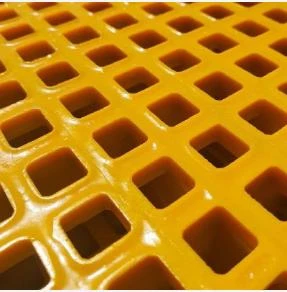loading...
- No. 9, Xingyuan South Street, Dongwaihuan Road, Zaoqiang County, Hengshui, Hebei, China
- admin@zjcomposites.com
- +86 15097380338
- Welcome to visit our website!
frp grating sheet
Understanding FRP Grating Sheets Applications and Advantages
Fiber Reinforced Plastic (FRP) grating sheets are engineered composite materials that have gained recognition in various industries for their outstanding properties and versatility. Comprising a polymer matrix reinforced with fibers—typically glass or carbon—FRP grating sheets offer significant benefits over traditional materials, making them an attractive option for applications that demand strength, durability, and corrosion resistance.
What is FRP Grating?
FRP grating is a type of flooring system made from a composite material that provides excellent support and resilience. It is lightweight yet strong, resulting from the high strength-to-weight ratio of its fiberglass or carbon fiber reinforcement. The fabrication process typically involves pultrusion, wherein resin-impregnated fibers are drawn through a heated die to form continuous profiles. These profiles can be shaped into various forms, including sheets, which can then be assembled into grating panels.
Applications of FRP Grating Sheets
1. Industrial Environments One of the primary applications of FRP grating sheets is in industrial settings, such as chemical plants, wastewater treatment facilities, and oil refineries. Their resistance to corrosion makes them ideal for environments where exposure to harsh chemicals is common, ensuring longevity and reducing maintenance costs.
2. Walkways and Platforms FRP grating is often used for walkways, platforms, and catwalks, especially in areas that require lightweight solutions that can support substantial loads. The slip-resistant surface of FRP sheets enhances safety for workers operating in these environments.
3. Marine Applications Due to their exceptional resistance to moisture and saltwater, FRP grating sheets are widely utilized in the marine industry for piers, docks, and boat ramps. Their non-conductive nature also adds safety in handling electrical installations near water.
4. Transportation and Infrastructure FRP grating is increasingly being employed in bridge construction and transportation applications due to its lightweight properties, which contribute to reduced load on supporting structures. Additionally, its ability to withstand environmental stresses makes it a reliable choice for public infrastructure.
5. Architectural Features In recent years, FRP grating has also found a niche in architectural designs. It can be finished in various colors and textures, offering an aesthetic appeal in addition to its functional benefits. Designers leverage FRP grating for custom flooring solutions, balustrades, and facades.
frp grating sheet

Advantages of FRP Grating Sheets
- Corrosion Resistance One of the standout features of FRP grating sheets is their resistance to corrosion. Unlike steel or wood, FRP won't rust or rot, which translates into lower replacement costs and longer service life.
- Lightweight FRP materials are significantly lighter than traditional steel grating, which makes installation easier and reduces the structural load. This attribute is particularly advantageous in applications where weight restrictions are critical.
- High Load-Bearing Capacity Despite their lightweight nature, FRP grating sheets demonstrate a remarkable load-bearing capacity, making them suitable for various applications where heavy machinery may be in use.
- Ease of Maintenance The smooth surface of FRP grating requires minimal maintenance. Cleaning can be as simple as hosing down the surface, and there is no need for frequent replacement due to wear and tear as seen in wooden or steel alternatives.
- Environmental Resistance FRP materials are designed to withstand various environmental factors, including UV exposure and extreme temperatures. This resilience ensures that FRP grating maintains its integrity in harsh conditions.
- Safety Features Many FRP grating products come with defined slip-resistant surfaces, enhancing safety in both industrial and public settings. This is particularly critical in wet or oily environments where slips and falls can lead to serious injuries.
Conclusion
FRP grating sheets represent a significant advancement in material technology, combining functionality with versatility. Their unique properties make them suitable for a wide array of applications, from industrial to architectural uses. As industries continue to seek innovative solutions to improve safety, reduce maintenance costs, and enhance efficiency, the adoption of FRP grating is expected to grow. With its plethora of benefits, including exceptional corrosion resistance, lightweight design, and high load-bearing capability, FRP grating sheets stand out as a superior alternative to traditional materials, paving the way for safer and more durable infrastructure.
-
GRP Structures: The Future of Lightweight, High-Performance EngineeringNewsJun.20,2025
-
FRP Water Tank: High-Performance Storage for Corrosive and Clean Water SystemsNewsJun.20,2025
-
FRP Square Tube: The New Industry Standard for Chemical and Structural ApplicationsNewsJun.20,2025
-
FRP Pultruded Profiles: The Ultimate Choice for Lightweight Structural StrengthNewsJun.20,2025
-
FRP Handrails: The Safer, Smarter, and Stronger Choice for Modern InfrastructureNewsJun.20,2025
-
FRP Grating: The Smart Solution for Durable, Lightweight Industrial FlooringNewsJun.20,2025
-
Why Choose a Galvanized Water Tank for Your Storage NeedsNewsMay.21,2025
